First Results on the Revealing of Cognate Ancestors among the Particles of the Primary Cosmic Rays That Gave Rise to Extensive Air Showers Observed by the GELATICA Network
Abstract
1. Introduction
2. Materials and Methods
2.1. The Method of Ascertainment of the Possible Historical Proximity of Two Remote Showers
- The observation times t and the dispersions στ2 of their estimations;
- The coordinates r of positions of the showers’ cores at the observation moments and the covariance matrixes M of their estimations;
- The unit directional vectors n of the shower fronts’ movement directions and the covariance matrixes D of their estimations.
- Zone 1: 0 < K ≤ 2—Unrealizable ancestors approach in the future (they are absorbed already),
- Zone 2: 2 < K ≤ 3—Unreliable ancestors proximity in the past (the value of Δ is too big in comparison with σΔ),
- Zone 3: 3 < K ≤ 4—Possibly historically related ancestors of the two showers,
2.2. Short Description of the GELATICA Network
2.3. Choice of the Single Common Inertial Coordinate System and Complete Estimated Data Representation in this Special Reference Frame
3. Results
Search for Possibly Cognate Ancestors of Extensive Air Showers among the Observed Pairs of Remote Showers
4. Discussion
5. Conclusions
Author Contributions
Funding
Institutional Review Board Statement
Informed Consent Statement
Data Availability Statement
Acknowledgments
Conflicts of Interest
References
- Weiler, J. Big Bang Cosmology, Relic Neutrinos, and Absorption of Neutrino Cosmic Rays. Astrophys. J. 1984, 285, 495. [Google Scholar] [CrossRef]
- Aloisio, R.; Boncioli, D.; Di Matteo, A.; Grillo, A.; Petrera, S.; Salamida, F. Cosmogenic neutrinos and ultra-high energy cosmic ray models. J. Cosmol. Astropart. Phys. 2015, 2015, 6. [Google Scholar] [CrossRef]
- Coleman, S.; Glashow, S.L. Cosmic ray and neutrino tests of special relativity. Phys. Lett. B 1997, 405, 249–252. [Google Scholar] [CrossRef]
- Bhattacharjee, P.; Sigl, G. Origin and propagation of extremely high-energy cosmic rays. Phys. Rep. 2000, 327, 109–247. [Google Scholar] [CrossRef]
- Bietenholz, W. Cosmic rays and the search for a Lorentz Invariance Violation. Phys. Rep. 2011, 505, 145–185. [Google Scholar] [CrossRef]
- Tasson, J.D. What Do We Know About Lorentz Invariance? Rep. Prog. Phys. 2014, 77, 062901. [Google Scholar] [CrossRef] [PubMed]
- Rubtsov, G.; Satunin, P.; Sibiryakov, S. Constraints on violation of Lorentz invariance from atmospheric showers initiated by multi-TeV photons. J. Cosmol. Astropart. Phys. 2017, 1705, 049. [Google Scholar] [CrossRef]
- Mohanmurthy, P.; Narayan, A.; Dutta, D. A test of local Lorentz invariance with Compton scattering asymmetry. Mod. Phys. Lett. A 2016, 31, 1650220. [Google Scholar] [CrossRef]
- Alcantara, E.; Anchordoqui, L.A.; Soriano, J.F. Hunting for superheavy dark matter with the highest-energy cosmic rays. Phys. Rev. D 2019, 99, 103016. [Google Scholar] [CrossRef]
- Supanitsky, A.; Medina-Tanco, G. Ultra high energy cosmic rays from super-heavy dark matter in the context of large exposure observatories. J. Cosmol. Astropart. Phys. 2019, 2019, 036. [Google Scholar] [CrossRef]
- Berezhiani, Z.; Bento, L. Fast Neutron—Mirror Neutron Oscillation and Ultra High Energy Cosmic Rays. Phys. Lett. 2006, B635, 253–259. [Google Scholar] [CrossRef]
- Berezhiani, Z.; Gazizov, A. Neutron oscillations to parallel world: Earlier end to the cosmic ray spectrum? Eur. Phys. J. C 2012, 72, 2111. [Google Scholar] [CrossRef]
- Ochi, N.; Iyono, A.; Kimura, H.; Konishi, T.; Nakamura, T.; Nakatsuka, T.; Ohara, S.; Ohmori, N.; Okei, K.; Saitoh, K.; et al. Search for large-scale coincidences in network observation of cosmic ray air showers. J. Phys. G Nucl. Part. Phys. 2003, 29, 1169–1180. [Google Scholar] [CrossRef]
- Iyono, A.; Matsumoto, H.; Okei, K.; Tsuji, S.; Ohara, S.; Ochi, N.; Konishi, T.; Takahashi, N.; Yamamoto, I.; Nakatsuka, T.; et al. Parallel and Simultaneous EAS Events Due to Gerasimova-Zatsepin Effects Observed by LAAS Experiments. In Proceedings of the 31st ICRC, Łódź, Poland, 7–15 July 2009; Available online: http://icrc2009.uni.lodz.pl/proc/pdf/icrc0941.pdf (accessed on 23 July 2022).
- Pospıšil, S.; Pridal, P.; Smejkal, J.; Soluk, R.; Štekl, I.; Vıcha, V. ALTA/CZELTA—A sparse very large air shower array: Overview of the experiment and first results. In Proceedings of the 31st ICRC (2009), Łódź, Poland, 7–15 July 2009; Available online: http://icrc2009.uni.lodz.pl/proc/pdf/icrc1300.pdf (accessed on 21 July 2022).
- Blaschke, F.; Čermák, J.; Hubík, J.; Lichard, P.; Přidal, P.; Smejkal, J.; Smolek, K.; Stek, I.; Vicha, V. CZELTA: An overview of the CZECH large-area time coincidence array. Astrophys. Space Sci. Trans. 2011, 7, 69–73. Available online: www.astrophys-space-sci-trans.net/7/69/2011 (accessed on 22 July 2022). [CrossRef]
- Verbetsky, Y.; Svanidze, M.; Iashvili, A.; Tskhadadze, E.; Kokorashvili, D. First results on the spatiotemporal correlations of the remote Extensive Air Shower pairs. J. Phys. Conf. Ser. 2013, 409, 012085. Available online: http://iopscience.iop.org/article/10.1088/1742-6596/409/1/012085/meta;jsessionid=89322C00C25D03FA0B0D63C56F0B2333.c5.iopscience.cld.iop.org (accessed on 21 July 2022). [CrossRef]
- Abbrescia, M.; Baldini, L.; Ferroli, R.B.; Batignani, G.; Battaglieri, M.; Boi, S.; Bossini, E.; Carnesecchi, F.; Chiavassa, A.; Cicalo, C.; et al. Search for long distance correlations between extensive air showers detected by the EEE network. Eur. Phys. J. Plus 2018, 133, 34. [Google Scholar] [CrossRef]
- The Pierre Auger Collaboration. The Pierre Auger Cosmic Ray Observatory. Nucl. Instrum. Methods Phys. Res. Sect. A 2015, 798, 172–213. [Google Scholar] [CrossRef]
- Ogio, S.; for the Telescope Array Collaboration. Telescope array experiment. EPJ Web Conf. 2019, 208, 08002. [Google Scholar] [CrossRef][Green Version]
- Colle, J.; Lascaris, E.; Tanczos, I. The HiSPARC project: Science, technology and education. AIP Conf. Proc. 2007, 944, 44–50. [Google Scholar]
- Bardeen, M.; Wayne, M.; Young, M.J. QuarkNet: A Unique and Transformative Physics Education Program. Educ. Sci. 2018, 8, 17. [Google Scholar] [CrossRef]
- Carlson, B.E.; Brobeck, E.; Jillings, C.J.; Larson, M.B.; Lynn, T.W.; McKeown, R.D.; Hill, J.E.; Falkowski, B.J.; Seki, R.; Sepikas, J.; et al. Search for correlated high energy cosmic ray events with CHICOS. J. Phys. G Nucl. Part. Phys. 2005, 31, 409–416. [Google Scholar] [CrossRef]
- Smolek, K.; Cermak, J.; Lichard, P.; Nyklicek, M.; Pospisil, S.; Pridal, P.; Smejkal, J.; Stekl, I.; Vicha, V.; Vojik, M.; et al. Measurement of High Energy Cosmic Rays in the Experiment CZELTA. In Proceedings of the 2008 IEEE Nuclear Science Symposium Conference Record, Dresden, Germany, 19–25 October 2008; pp. 720–721. [Google Scholar]
- Abbrescia, M.; Avanzini, C.; Baldini, L.; Ferroli, R.B.; Batignani, G.; Bencivenni, G.; Bossini, E.; Bressan, E.; Chiavassa, A.; Cicalò, C.; et al. EEE—Extreme Energy Events: An astroparticle physics experiment in Italian High Schools. J. Phys. Conf. Ser. 2016, 718, 082001. [Google Scholar] [CrossRef]
- Ochi, N.; Iyono, A.; Konishi, T.; Nakamura, T.; Nakatsuka, T.; Ohara, S.; Ohmori, N.; Okei, K.; Saitoh, K.; Tada, J.; et al. The status and future prospect of the LAAS project. In Proceedings of the 28th International Cosmic Ray Conference, Tsukuba, Japan, 31 July–7 August 2003; Volume 2, pp. 1005–1008. [Google Scholar]
- Gress, O.; Astapov, I.; Budnev, N.; Bezyazeekov, P.; Bogdanov, A.; Boreyko, V.; Brückner, M.; Chiavassa, A.; Chvalaev, O.; Dyachok, A.; et al. The wide-aperture gamma-ray telescope TAIGA-HiSCORE in the Tunka Valley: Design, composition and commissioning. Nucl. Instrum. Methods Phys. Res. Sect. A Accel. Spectrom. Detect. Assoc. Equip. 2017, 845, 367–372. Available online: https://www.sciencedirect.com/science/article/abs/pii/S016890021630849X (accessed on 21 July 2022). [CrossRef]
- Manana, S.; Yuri, V.; Yuri, B.; Ala, J.; Abesalom, I.; Edisher, T.; Lali, R.; Levan, K.; Davit, K. First results obtained by the GELATICA Network of the Cosmic Rays Stations in Georgia. GESI Phys. 2011, 5, 84–96. Available online: http://gesj.internet-academy.org.ge/download.php?id=1846.pdf (accessed on 21 July 2022).
- Cosmic-Ray Extremely Distributed Observatory (CREDO). Available online: http://credo.science/ (accessed on 21 July 2022).
- Homola, P.; Beznosko, D.; Bhatta, G.; Bibrzycki, Ł.; Borczyńska, M.; Bratek, Ł.; Budnev, N.; Burakowski, D.; Alvarez-Castillo, D.; Cheminant, K.A.; et al. Cosmic-Ray Extremely Distributed Observatory. Symmetry 2020, 12, 1835. [Google Scholar] [CrossRef]
- CREDO Collaboration. Hunters of Cosmic Ray Particles Come Together in CREDO; EurekAlert. 2019. Available online: https://www.eurekalert.org/news-releases/710978 (accessed on 21 July 2022).
- Verbetsky, Y.; Svanidze, M. On the method of ascertainment of the possible historical proximity of two Extensive Air Showers. arXiv 2020, arXiv:2006.07903. [Google Scholar]
- Verbetsky, Y.; Svanidze, M.; Beznosko, D.; Homola, P. On the possible method of identification of two probably cognate Extensive Air Showers. In Proceedings of the 37th International Cosmic Ray Conference (ICRC2021), Berlin, Germany, 12–23 July 2021; Volume 424. Available online: https://pos.sissa.it/395/424 (accessed on 21 July 2022). [CrossRef]
- Hansen, S.; Jordan, T.; Kiper, T.; Claes, D.; Snow, G.; Berns, H.; Burnett, T.H.; Gran, R.; Wilkes, R.J. Low Cost Data Acquisition Card for Network Cosmic Ray Detector. IEEE Trans. Nucl. Sci. 2004, 51, 926–930. Available online: http://neutrino.phys.washington.edu/~berns/WALTA/Qnet2/ (accessed on 21 July 2022). [CrossRef]
- Bassi, P.; Clark, G.; Rossi, B. Distribution of Arrival Times of Air Shower Particles. Phys. Rev. 1953, 92, 441. Available online: http://prola.aps.org/abstract/PR/v92/i2/p441_1 (accessed on 21 July 2022). [CrossRef]
- Svanidze, M.S.; Verbetsky, Y.G. Improved Method of the Extensive Air Shower Arrival Direction Estimation. arXiv 2008, arXiv:0804.1751. [Google Scholar]
- Verbetsky, Y.; Svanidze, M.; Iashvili, A.; Kakabadze, L. Extensive Air Showers’ Arrival Direction Distribution by TBS Array. Int. J. High Energy Phys. 2014, 1, 49–54. Available online: http://www.sciencepublishinggroup.com/journal/archive.aspx?journalid=124&issueid=-1 (accessed on 21 July 2022). [CrossRef]
- Svanidze, M.; Verbetsky, Y.; Iashvili, I.; Iashvili, A.; Gongadze, A.; Kakabadze, L.; Kapanadze, G.; Tskhadadze, E.; Chonishvili, G. Angular distribution of extensive air showers by TEL array under GELATICA experiment. GESJ Phys. 2016, 15, 54–62. Available online: http://gesj.internet-academy.org.ge/download.php?id=2740.pdf (accessed on 21 July 2022).
- Verbetsky, Y.; Svanidze, M.; Iashvili, A.; Iashvili, I.; Kakabadze, L.; Jonjoladze, N. Investigation of the arrivals’ directions differences for consecutive extensive air showers using the data taken by TEL goniometer under gelatica network. GESJ Phys. 2019, 22, 27–33. Available online: http://gesj.internet-academy.org.ge/download.php?id=3274.pdf (accessed on 21 July 2022).
- International Earth Rotation Service (IERS). Available online: https://www.iers.org/IERS/EN/Home/home_node.html (accessed on 21 July 2022).
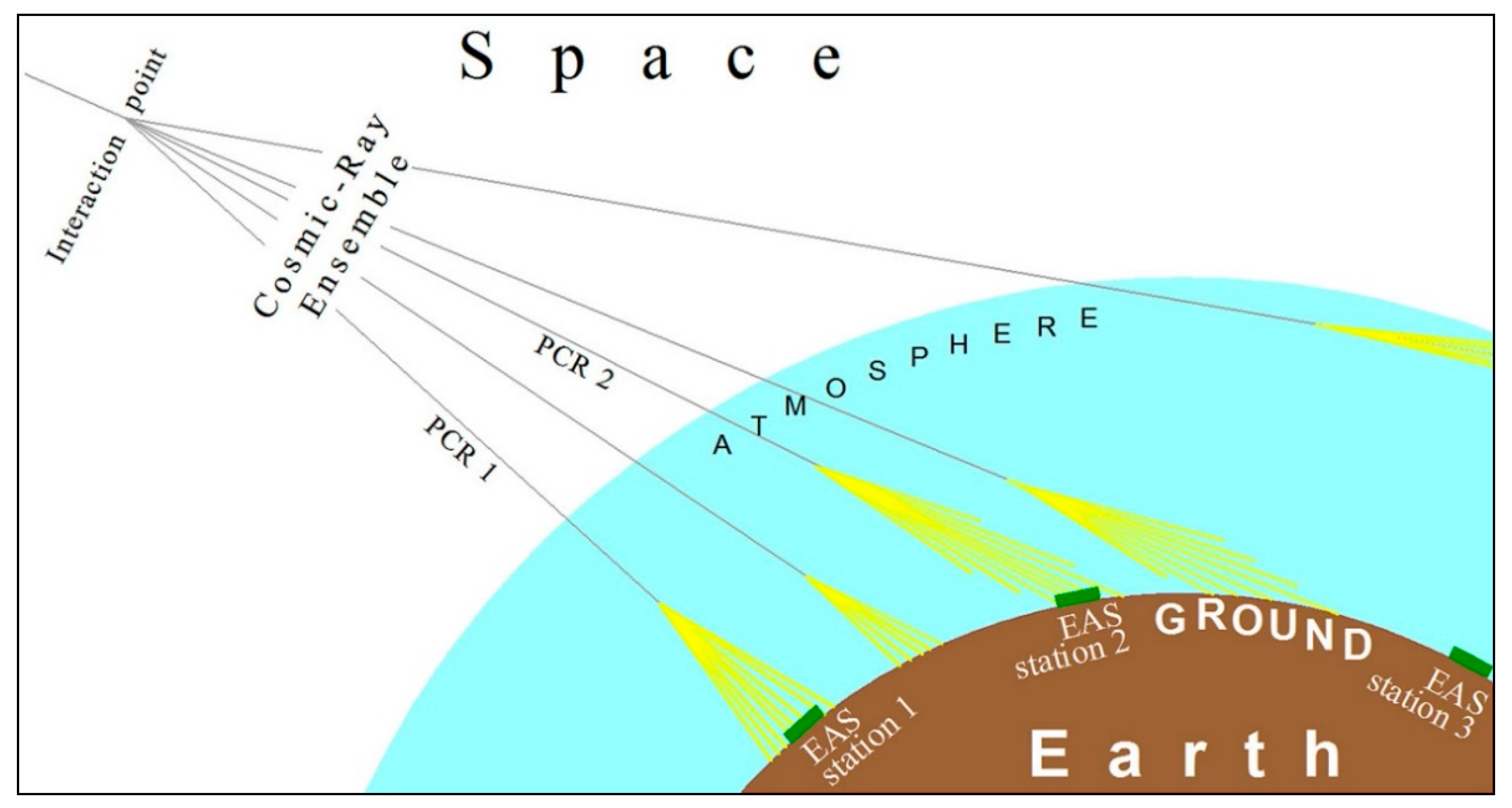


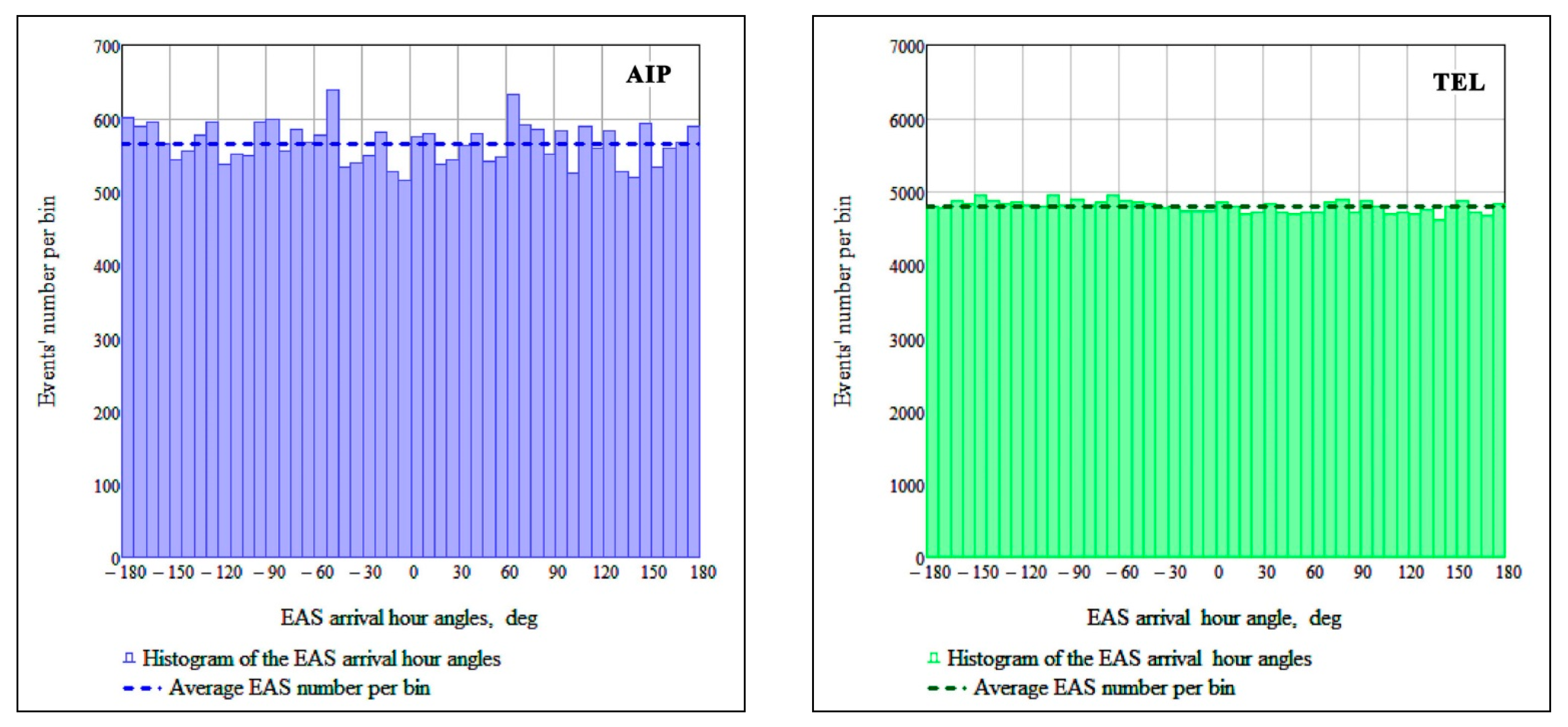
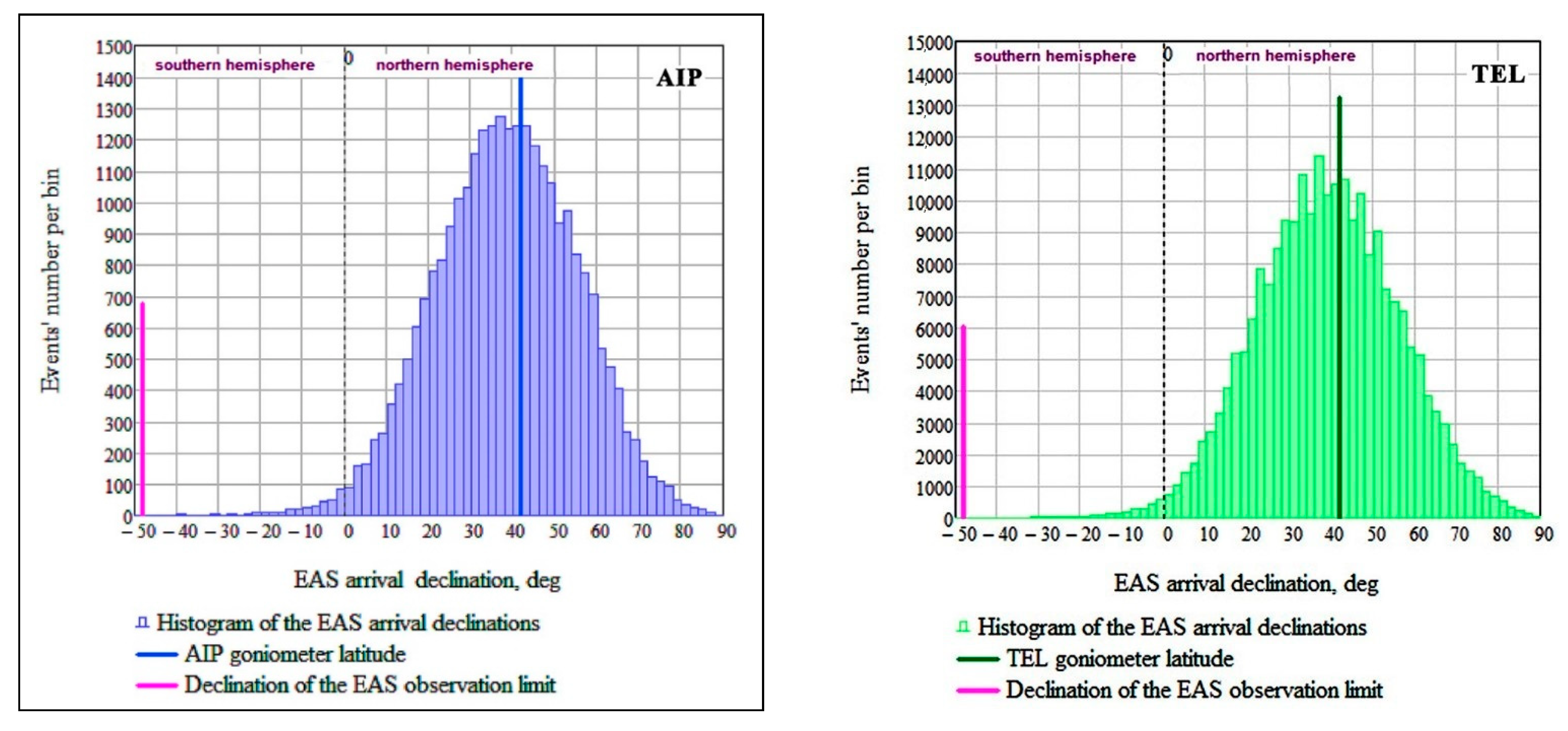
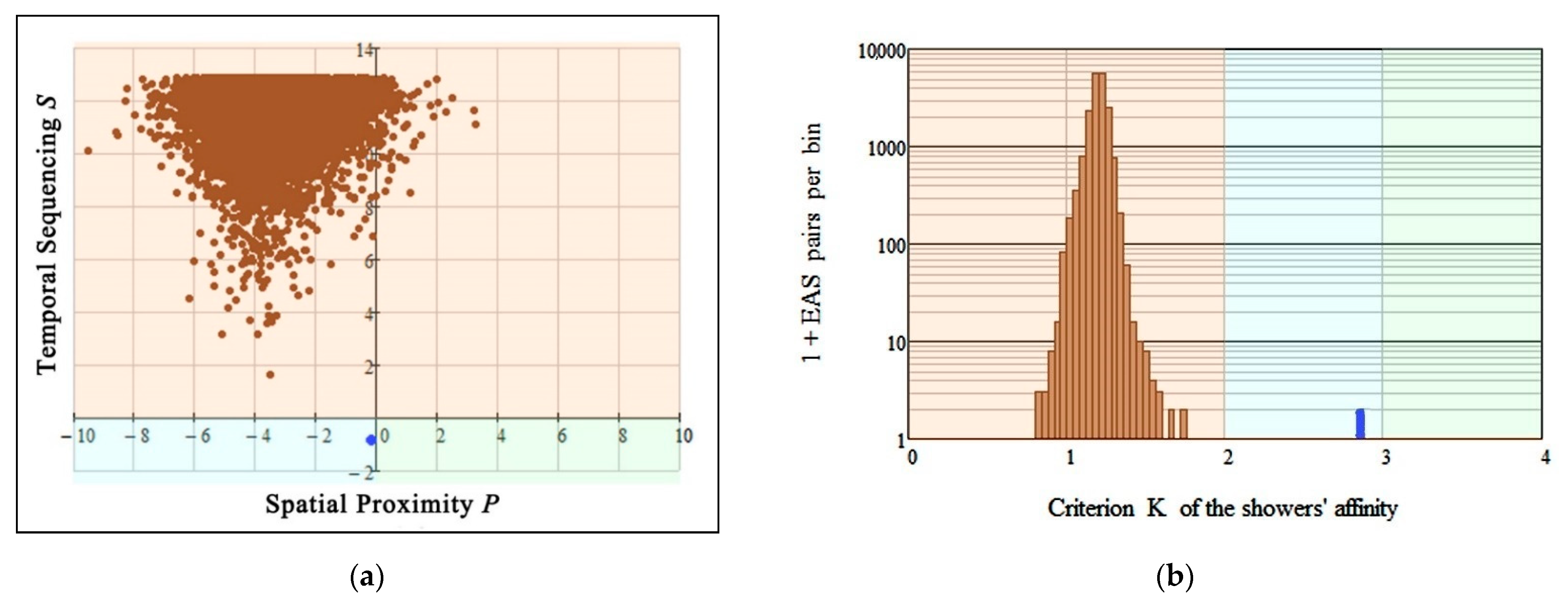
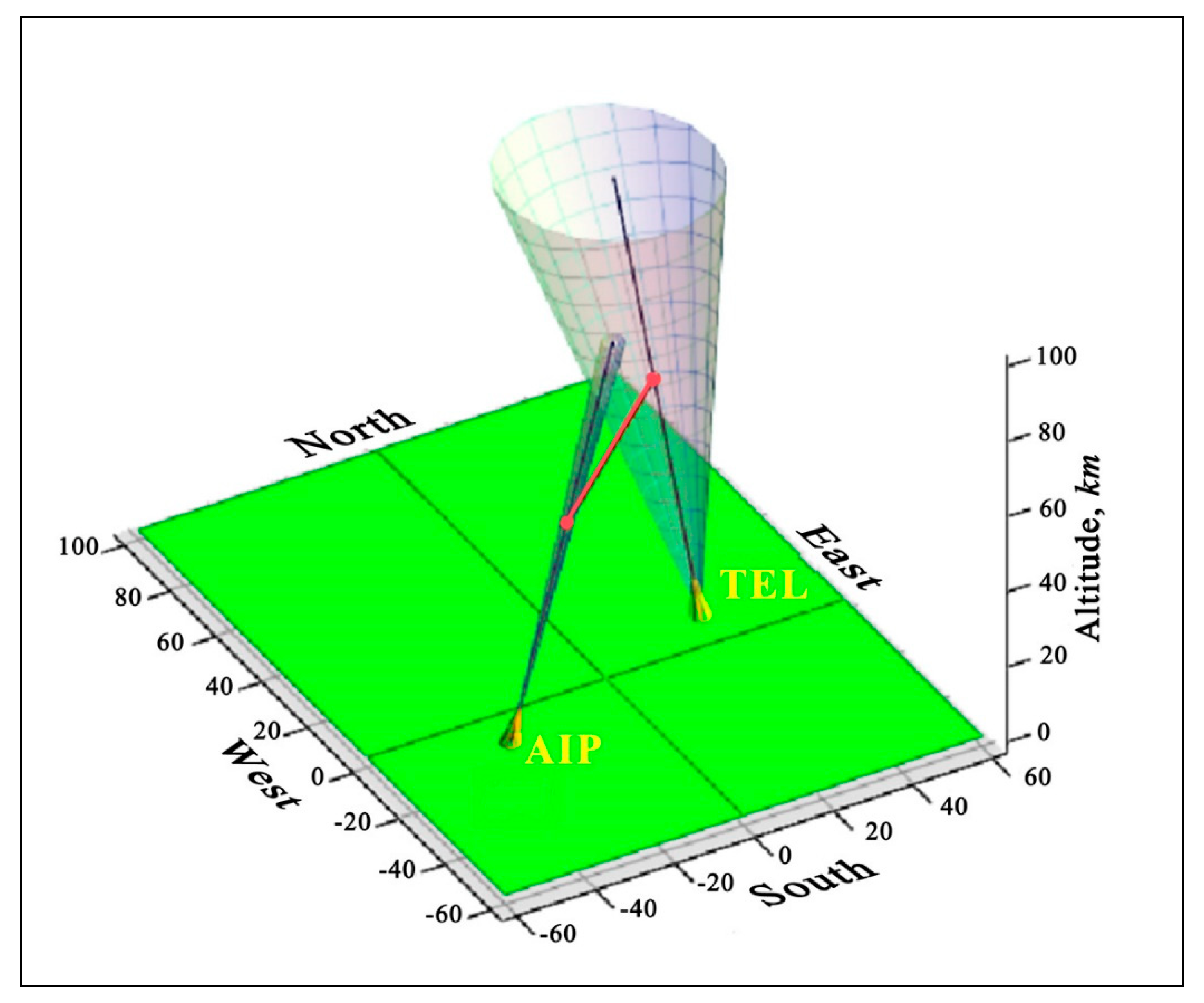
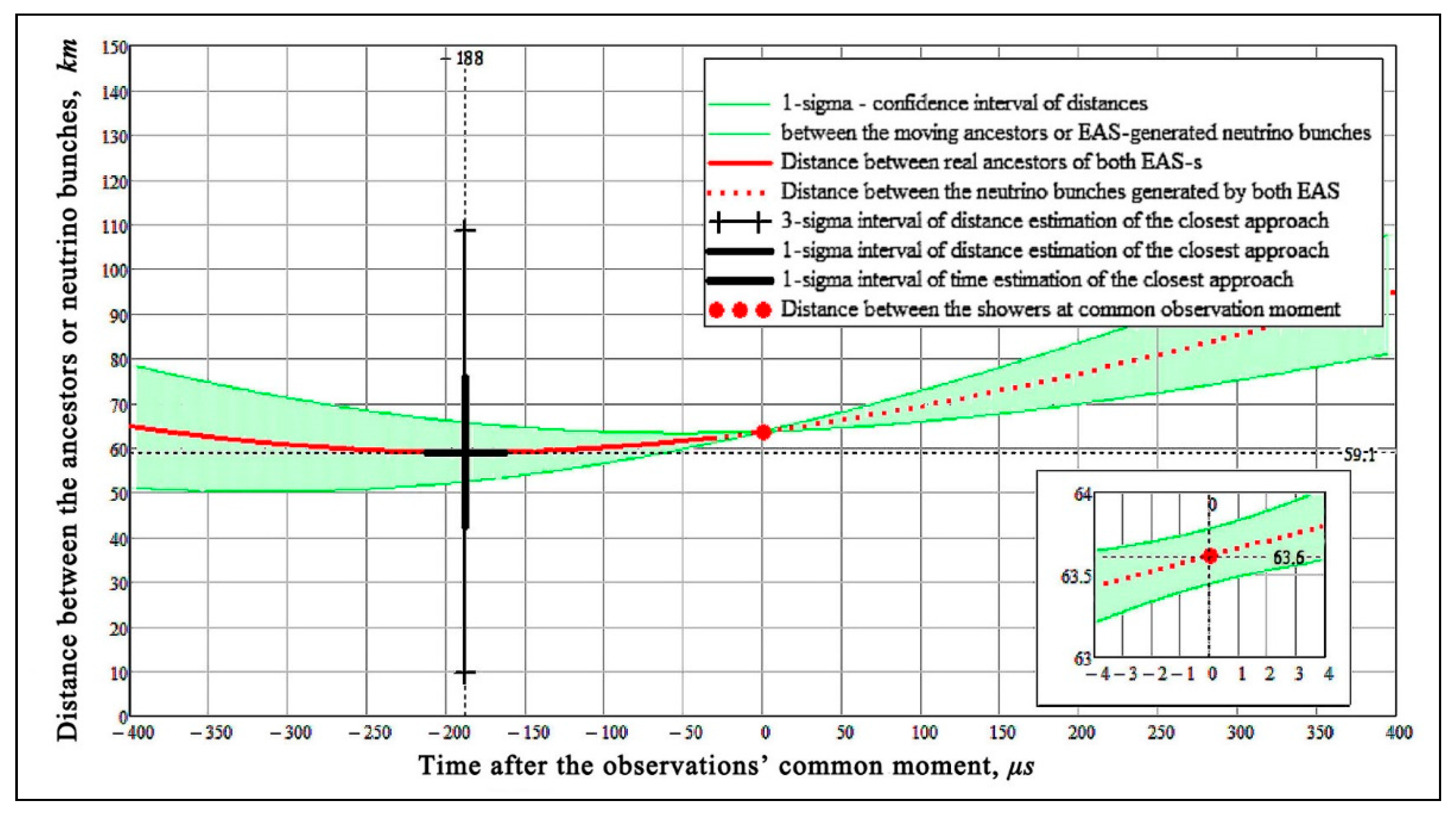
| City | Goniometer’s Designation | Location |
|---|---|---|
| Tbilisi | AIP | E. Andronikashvili Institute of Physics (Tbilisi State University), building II |
| GTU | Georgian Technical University, building IV | |
| HEP | High Energy Physics Institute (Tbilisi State University) | |
| Telavi | TEL | J. Gogebashvili Telavi State University, building I |
| GTU | HEP | TEL | |
|---|---|---|---|
| AIP | (2792 ± 9) m | (2727 ± 9) m | (63,613 ± 9) m |
| GTU | (5519 ± 8) m | (60,945 ± 8) m | |
| HEP | (66,346 ± 8) m |
| Quantity | AIP | TEL | |
|---|---|---|---|
| Geographic latitude ψo | 41.720329° N | 41.910301° N | |
| Geographic longitude λo | 44.744092° E | 45.468106° E | |
| Local altitude ho | 495 m a.s.l | 845 m a.s.l | |
| Approximate dimensions | 13.0 m × 13.0 m | 10.2 m × 11.2 m | |
| Upright atmospheric mass depth | 972.8 g/cm2 | 936.4 g/cm2 | |
| Air density at actual location | 1167 g/m3 | 1129 g/m3 | |
| Total number of the observed showers | 27,147 | 230,178 | |
| Estimated observation rate of the showers upon the complete set of observed showers | (2.66 ± 0.1) h−1 | (24.5 ± 0.8) h−1 | |
| Calculated quantities | Threshold of average sensitivity of all detectors, particles per detector | 8.156 | 2.628 |
| The lowest energy of the observable showers | 0.77 PeV | 0.23 PeV | |
| The average energy of the observable showers | 25 PeV | 9.6 PeV | |
| The greatest attainable distance to the shower cores | 2194 m | 3085 m | |
| The average distance to the shower cores | 106 m | 117 m | |
| The root mean square distance to the shower cores ρc | 150 m | 165 m | |
| Obtained Quantity | AIP | TEL |
|---|---|---|
| Total numbers of the observed showers | 27,147 | 23,0178 |
| The overall time of simultaneous observations | 9329 h ≈ 388.7 days | |
| The numbers of the observed showers during the simultaneous observations’ period | 24,325 | 213,997 |
| Estimated observation rates of the showers upon the simultaneous observations’ period | (2.61 ± 0.02) h−1 | (22.9 ± 0.5) h−1 |
| Estimated Quantity | AIP | TEL | |
|---|---|---|---|
| Observation day | 23 February 2021 | 23 February 2021 | |
| Observation UTC time | t1 = 29,064.3925780 s | t2 = 29,064.3925780 s | |
| Equatorial reference frame | Estimated directional unit vectors of the EASs’ front movement | ||
| Covariance matrixes of estimations of the components of the directional unit vectors | |||
| Horizontal reference frame in the middle point | Coordinates of the observation points (they are opposite vectors definitionally) | km | km |
| Local directional unit vectors of the EASs’ front movement | |||
| Equivalent average angular error of the direction estimations | 0.7° | 6.5° | |
| Parameter | Value | |
|---|---|---|
| Observations’ day | 23 February 2021 | |
| Observations’ common UTC time | t = 29,064.392578 s | |
| formulae (1–5) | The interval of time from the ancestors’ closest approach till the common observations’ moment | |
| The Lorentz invariant spacelike interval of the ancestors’ closest approach | ||
| The value of the temporal sequencing parameter | ||
| The value of the spatial proximity parameter (with use of optional coefficient kσ = 3) | ||
| The value of the affinity criterion | ||
Publisher’s Note: MDPI stays neutral with regard to jurisdictional claims in published maps and institutional affiliations. |
© 2022 by the authors. Licensee MDPI, Basel, Switzerland. This article is an open access article distributed under the terms and conditions of the Creative Commons Attribution (CC BY) license (https://creativecommons.org/licenses/by/4.0/).
Share and Cite
Verbetsky, Y.; Svanidze, M.; Ruimi, O.; Wibig, T.; Kakabadze, L.; Homola, P.; Alvarez-Castillo, D.E.; Beznosko, D.; Sarkisyan-Grinbaum, E.K.; Bar, O.; et al. First Results on the Revealing of Cognate Ancestors among the Particles of the Primary Cosmic Rays That Gave Rise to Extensive Air Showers Observed by the GELATICA Network. Symmetry 2022, 14, 1749. https://doi.org/10.3390/sym14081749
Verbetsky Y, Svanidze M, Ruimi O, Wibig T, Kakabadze L, Homola P, Alvarez-Castillo DE, Beznosko D, Sarkisyan-Grinbaum EK, Bar O, et al. First Results on the Revealing of Cognate Ancestors among the Particles of the Primary Cosmic Rays That Gave Rise to Extensive Air Showers Observed by the GELATICA Network. Symmetry. 2022; 14(8):1749. https://doi.org/10.3390/sym14081749
Chicago/Turabian StyleVerbetsky, Yuri, Manana Svanidze, Ophir Ruimi, Tadeusz Wibig, Levan Kakabadze, Piotr Homola, David E. Alvarez-Castillo, Dmitry Beznosko, Edward K. Sarkisyan-Grinbaum, Olaf Bar, and et al. 2022. "First Results on the Revealing of Cognate Ancestors among the Particles of the Primary Cosmic Rays That Gave Rise to Extensive Air Showers Observed by the GELATICA Network" Symmetry 14, no. 8: 1749. https://doi.org/10.3390/sym14081749
APA StyleVerbetsky, Y., Svanidze, M., Ruimi, O., Wibig, T., Kakabadze, L., Homola, P., Alvarez-Castillo, D. E., Beznosko, D., Sarkisyan-Grinbaum, E. K., Bar, O., Sushchov, O., & Tursunov, A. (2022). First Results on the Revealing of Cognate Ancestors among the Particles of the Primary Cosmic Rays That Gave Rise to Extensive Air Showers Observed by the GELATICA Network. Symmetry, 14(8), 1749. https://doi.org/10.3390/sym14081749












